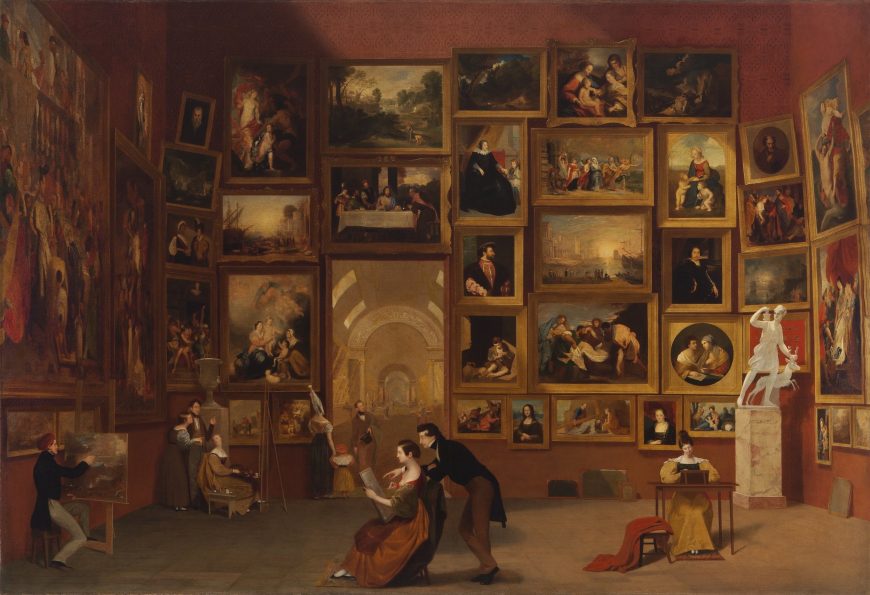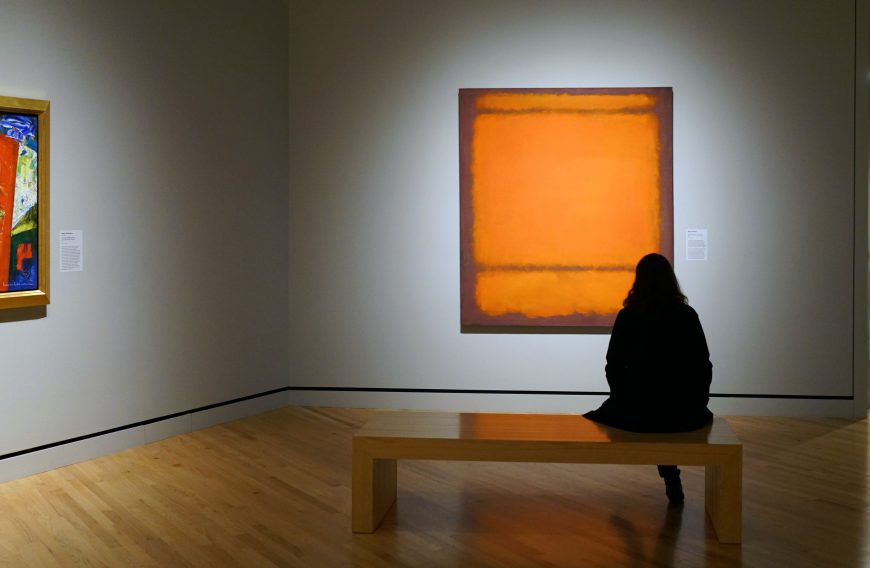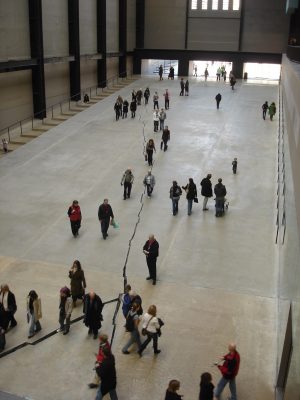“I was interested in ideas—not merely visual products.”Marcel Duchamp, The Museum of Modern Art Bulletin, 1946
Artists and museums: a world of contradictions
As a successful artist and a brilliantly rebellious one, Marcel Duchamp was a paradox—he made radically famous objects out of anti-iconic beliefs, used a deep knowledge of art history to turn art history on its head, and goaded museums while eventually becoming a museum favorite. In many ways he embodied the contradictions that surround the relationship of artists to art museums, from the late nineteenth century to the present.
Artists aspire to be shown in museums, the career-sweeping retrospective exhibition being one of the greatest honors; many also reject the stability, commerce, and popular appeal associated with the museum world. Often that resistance is channeled back into their work and, ironically, exhibited in art museums. This complex relationship far outstrips any notion of museums as inert spaces of display.

Samuel F. B. Morse, Gallery of the Louvre, 1831-33, oil on canvas, 187.3 x 274.3 cm (Terra Foundation for American Art)
The impact of museum collections: the case of the Louvre
Even in their most neutral forms, museums are and have long been catalysts for art making, most fundamentally as a primary source of inspiration. Sketching in the galleries and copying the old masters are tried and true methods of study, even for avant-garde painters like Paul Cézanne, who once described the Louvre Museum in Paris as “the book from which we learn to read.”
But the influence of the Louvre on artistic production was even more direct. As the site of display for government-sanctioned artistic production in France (via the system of the Salon), the Louvre—often considered the first modern art museum—was part of the production cycle of art: painters working under official tutelage were validated by the presentation of their work in the state museum, thus shaping and reinforcing the artistic canon.
This system guaranteed a conservative approach to art making, and it was something progressive French artists of the late nineteenth century, most notably the Impressionists, resisted. Although we are most familiar with their innovations of style and subject, it is important to remember the context in which these painters developed their novel forms of imagery, including their need to make a living by selling their pictures outside the patronage system of the Salon. Thus the Impressionists began exploring alternative places and aesthetics of exhibition, hanging their work in studios and the galleries of their art dealer-patrons in ways that would appeal to collectors buying for their own homes.

Mark Rothko, No. 210/No. 211 (Orange), 1960, oil on canvas, 175.3 x 160 cm (Crystal Bridges Museum of American Art)
The white cube
Under the influence of modernist design, this neutrality evolved into the gallery type we know today as the “white cube.” Characterized by clean walls, minimal architectural detail, and bright natural light, the “white cube” came to dominate the American museum scene from the 1930s onward. Architects, patrons, and museum directors like Alfred H. Barr, Jr. of The Museum of Modern Art (MoMA) in New York City valued this style as a discreet nearly invisible background to the artwork it highlighted. Many of the most important artistic movements of the post-World War II era seem made for such spaces, the large unframed canvases of Abstract Expressionists and Minimalists fitting naturally on expansive, unarticulated walls.
The white cube has been ideal for site-specific work as well. Though found in a range of settings, Sol LeWitt’s wall drawings and James Turrell’s light pieces, for example, are particularly well suited to the unencumbered spaces of modernist museums. These projects, in turn, point to the sizable role museums play not only in collecting and displaying artworks but in commissioning them.

Doris Salcedo, Shibboleth, crack in the floor of the Turbine Hall, Tate Modern, London, 2007-08 (photo: Nuno Nogueira, CC BY-SA 2.5)
To take two very different examples, the Renwick Gallery (part of the Smithsonian American Art Museum in Washington, D.C.), reopened in 2015 with an exhibition called “Wonder” consisting of nine installations devised in response to its newly renovated nineteenth-century galleries, while Tate Modern in London regularly commissions new work to fill its Turbine Hall—a massive industrial space that pushes artists in dramatic new directions.
Critiquing museums
Just as museums have positively nurtured artistic creativity, they have also become the target of serious critique from artists themselves. Early instigators in the rebellion against museums included Marcel Duchamp and his kindred spirits, the Dadaists. Their work challenged the museum’s categories of production, value, and significance by declaring discarded objects and random assemblages to be art.
Paradoxically, while working outside and against the norms of the museum, the Dadaists were intentionally responding to what those institutions represented. In this sense, the gesture of elevating ordinary objects like urinals and bottle-racks to objects worthy of display was a museum gesture.
Duchamp made his fascination with and antipathy for museums most evident in his Boîte-en-valise (“box in a suitcase”), a series of portable containers that held carefully crafted replicas of 69 of his own works. By playing on originals and reproductions, and acting as curator by selecting, labeling, and housing the miniature artworks, Duchamp called attention to the conditional, sometimes compromised role museums play in defining artistic success.
One ongoing concern of the museum’s critics are the powerful ties that bind museums to the art market. There are countless examples of artists struggling against this monetary system, with some of the most significant and sustained protests coming from conceptual artists of the 1960s and ‘70s, in a movement given the overarching label “institutional critique.” These artists insisted that art need not be a thing but could be an idea; by extension, art could live and thrive outside the confines of the museum and its fundamental mechanisms of acquisition and ownership.
Their rebellion took many forms, including multi-media projects that defied museum-based categories, performances that were fleeting and hence not collectible, and work that interacted with viewers such that it was always changing. The performance-based “happenings” of the period, using the name given them by Allan Kaprow, were in large part a response to the “corrosive” alliance he and his colleagues saw between money and art. Other artists of this generation continued to make durable things but focused on those that could not be contained within museum walls, such as the massive earthworks and environmental constructions of Robert Smithson and Walter de Maria.

Robert Smithson, Spiral Jetty, 1970, Rozel Point, Great Salt Lake, Utah (photo: Steven Zucker, taken June 2016, CC BY-NC-SA 2.0)
Ironically, these rebel artists and their works, or the surrounding documentation of them, are highly sought after by museums of modern and contemporary art. MoMA holds some of Yves Klein’s Anthropometry paintings that are essentially traces of performances pieces in which nude women rolled in Klein’s signature blue paint and then pressed their bodies to paper. It also owns instructions for a number of Sol LeWitt’s wall drawings, and possesses the photographic, drawn, and written documentation of artists ranging from Adrian Piper to Christo and Jean-Claude. Allan Kaprow is himself well represented in MoMA’s collection.
The irony is not just that these presumably uncollectible works ended up in museums; it is that museums were a significant spur to their production. Artists’ critiques have also come in the form of collection interventions, most influentially by Fred Wilson who has used museum holdings and operations across the United States and Europe as tools for questioning social and political hierarchies, particularly those surrounding race. Although Wilson’s complaint is institutional we might again consider the museum a positive actor in artistic creation: his objections to museums are what has driven his artistic production.
In 1999, MoMA organized the survey exhibition “Museum as Muse: Artists Reflect,” which included works by Wilson and many others—from mock guided audio tours (Janet Cardiff and Andrea Fraser) to a catalogue of all MoMA’s deaccessioned works (Michael Asher), from Candida Höfer’s photographic portraits of vacant museum spaces to Edward Ruscha’s The Los Angeles County Art Museum on Fire. The exhibition’s scope and range made clear how the often fraught relationship between artists and museums is also a powerful catalyst to art-making.

From Hyperallergic (May 22, 2019)
Ongoing tensions
The ongoing tensions around what museums do, who and what they include, and how they pay for it all are not going away anytime soon. Nor is the place of the artist in this debate; today the stakes go far beyond art itself. Most recently, the collective Forensic Architecture submitted an entry to the 2019 Whitney Biennial exhibition that is a direct critique of the museum’s vice chair Warren Kanders and his business manufacturing “law enforcement gear.” The artists’ work and the issues it highlights have spurred protests in the museum, marches in the street, and at least one other artist withdrawing work from the Biennial.
Many of these actions fit into the broader philosophical concept of the “museum-without-walls” (a term derived from the work of the French scholar André Malraux), and the idea that artwork can and must push beyond establishment boundaries, both literal and figurative. Sometimes, again paradoxically, this work is itself museum-ified.
The Homeless Museum of Art (HoMu) is a project of the artist Filip Noterdaeme who, among other things, has created an homage to Duchamp’s Boîte-en-valise in the form of MoMA Homeless (or MoMA HMLSS), a traveling box of unauthorized reproductions from MoMA’s collection made to protest the museum’s steep ticket price. This “ambulant mini-museum” has been displayed in France, Spain, and across the street from MoMA in Manhattan, and is on permanent view at the Homeless Museum headquarters, HoMu BKLYN, a rental apartment in Brooklyn. Duchamp would have surely appreciated this ironic skewering of art museum practice by practicing artists.

